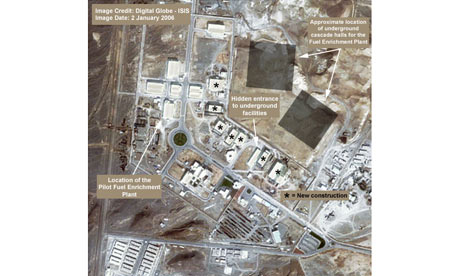The New York Times is reporting another puzzle in the Iranian nuclear saga:
When Iran was caught last September building a secret, underground nuclear enrichment plant at a military base near the city of Qum, the country’s leaders insisted they had no other choice. With its nuclear facilities under constant threat of attack, they said, only a fool would leave them out in the open.
So imagine the surprise of international inspectors almost two weeks ago when they watched as Iran moved nearly its entire stockpile of low-enriched nuclear fuel to an above-ground plant. It was as if, one official noted, a bulls-eye had been painted on it.
Why take such a huge risk?
That mystery is the subject of fervent debate in the White House and the C.I.A., and among European, Israeli and Arab officials trying to decode Iran’s intentions. The theories run from the bizarre to the mundane: Under one, Iran is actually taunting the Israelis to strike first. Under another, it is simply escalating the confrontation with the West to win further concessions in negotiations that have dragged on four months. The simplest explanation is that Iran has run short of suitable storage containers for radioactive fuel, so it had to move everything.
Julian Borger at The Guardian (UK) has more:
They were many striking elements in the new International Atomic Energy Agency report on Iran, not least its blunt language on the "possible military dimensions" of the Iranian programme. But the strangest part of it was this:
On 14 February 2010, Iran, in the presence of Agency inspectors, moved approximately 1950 kg of low enriched UF6 from FEP to the PFEP feed station. The Agency inspectors sealed the cylinder containing the material to the feed station.
That means that Iran took 94% of its entire stock of low enriched uranium (LEU) from the huge underground tunnels and chambers of its Fuel Enrichment Plant at Natanz and brought it to the surface, to its Pilot Fuel Enrichment Plant (see satellite picture above), which is currently producing 20% enriched uranium, and which is clearly visible from the air.
This stunning move is both provocative and risky. It is provocative because it signals an intention to enrich its LEU from its current level of purity of 3.5% U-235 up to 20%, which is most of the way, in engineering terms, to making weapons-grade material. [Arms Control Wonk has a good explanation of why in the world of uranium enrichment, 20 is closer to 90 than it is to 3.5]
Even if Iran had the technology to turn the 20% uranium into fuel rods for its medical research reactor in Tehran, it does not need two tonnes of LEU. According to ISIS, that much LEU would render about 200kg of 20% uranium. The Tehran Research Reactor needs no more than 18.4 kg annually.
The move is risky because it involves shifting Iran's crown jewels, its 2-tonne LEU stockpile, from subterranean safety where it was invisible to Israeli air force targeteers, to a clearly defined location that might as well have a bullseye painted on the roof.
Why would a regime that is normally so paranoid about its LEU leave itself so vulnerable? One possible explanation, being mused on by British government analysts, is that the regime is deliberately inviting an Israeli air strike with the aim of creating a crisis, and using that crisis to crush dissent even more brutally than it is doing currently.
It is a terrifying idea, but not the only possible explanation. It may be, as David Albright at ISIS suggests, that the Natanz technicians were in a hurry to fulfil President Ahmadinejad's orders to enrich to 20%, and it was quicker to drive the whole cask of enriched uranium hexafluoride up the ramp to the pilot plant, than try to decant it into small containers.
A third possibility is that Iran is playing poker, bringing out its trump in an attempt to get the international community to fold, and agree to supply Iran with fuel rods to the TRR without Iran having to export its LEU in advance as it initially agreed to do in Geneva last October. Tehran may believe that the danger of an Israeli air strike is minimal because the repercussions in the Gulf would be so devastating.
All three versions are all quite plausible, and they are all extremely dangerous. Israel may not be considering a strike imminently and appears content for the time being to explore how far sanctions will go, but that position may not last. The Israelis may consider 2010 a brief window of opportunity, following the exposure of the secret enrichment plant near Qom, and before Iran gets very far with the ten new ones it says it wants to build.
This report was issued on February 18, but Iran's curious relocation of its low-enriched uranium stores has received little coverage in the MSM. You can read the IAEA Iran report
here (pdf).





Iran knows that our president does not have the intestinal fortitude to launch or sanction a strike. With Bush/Cheney, our enemies feared and respected us - this included the bed-wetting liberals...
ReplyDeleteNow, with Hope and Change, we simply are not kissing their ass enough, or extending our hand enough, or simply not bowing enough...
What a joke of a president and what a joke of a country. It's the sequel of the Jimmy Carter President, entitled: "Jimmy Carter II - When Sasha and Malea are old enough, I will seek their advice on foreign affairs, like Jimmy did with Amy"...